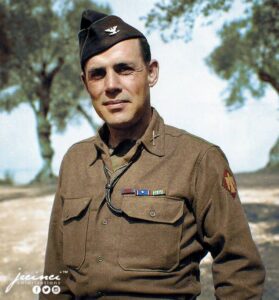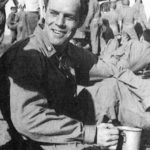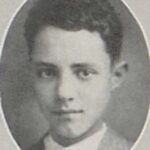Ranger William O. Darby

Born: 8 February 1911 Fort Smith, Arkansas
Died: 30 April 1945 Po Valley, Italy He was KIA
Army Serial Number: O-19133
Ranger Battalion/Company: Commander of 1st Ranger BN then Ranger Force
Rank: Colonel
Enlisted: Commissioned as a 2nd LT from West Point 13 June 1933. 1st BN 82nd Field Artillery of 1st Cavalry
Battles/Campaigns/Significants: N Africa, Tunisia, Sicily and Italy
Medals/Awards: SSM, PH, EAME, CIB, BSM, 2-DSC, BDSO, 2-PUC
Biography
Bill Darby was born on February 8, 1911, in Fort Smith (Sebastian County). His father, Percy Darby, owned a print shop, and his mother, Nell, was a homemaker. He had a younger sister named Doris. Darby attended Belle Grove School through the sixth grade and then went to Fort Smith Senior High School. After his graduation in 1929, he received an appointment to West Point Military Academy, where he served as a cadet company commander. He graduated from West Point with a BS on June 13, 1933. He was commissioned as a second lieutenant and assigned to the First Battalion, Eighty-second Field Artillery of the First Cavalry, the only mounted artillery unit in the army, at Fort Bliss, Texas. He was promoted to captain on October 1, 1940, and later received amphibious training.
He was assigned as aide-de-camp to Major General Russell P. Hartle, commander of the Thirty-fourth Infantry Division, shortly after the bombing of Pearl Harbor in 1941 and deployed with the division to Northern Ireland in January 1942. General Hartle chose Captain Darby to organize and train a new elite commando unit. Darby received a promotion to major, and the official activation of the First Ranger Battalion took place on 19 June 1942.
Darby went into action when his rangers spearheaded the Center Taskforce as a part of Operation Torch under the command of Major General Lloyd Fredendall during the November 8, 1942, North Africa Invasion. Darby’s unit executed a number of successful night attacks. They landed at Arzew, Algeria, near Oran, where Darby served as the military mayor of the city for several months until he and his troops were sent to the Tunisian Front.
Near the close of the Tunisian Campaign, Darby set about training and expanding the rangers into three battalions. On July 10, 1943, the First, Third, and Fourth Ranger battalions spearheaded the invasion of Sicily. The three ranger battalions were the first to land during the invasion of Italy on September 9, 1943. Early in the morning of January 22, 1944, they landed unopposed in the harbor of Anzio. They had control from the moment they landed. On January 30, 1944, the First and Third battalions, however, suffered severe casualties in the battle for Cisterna, Italy. The Fourth Battalion also suffered heavy losses and now alone made up the ranger force. Many of those Rangers became POWs. Those that were left in 1st, 3rd and 4th Battalions were consolidated with the First Special Service Force. 198 Rangers returned home that had earned enough active duty time.
Darby was reassigned to head the 179th Infantry Regiment, Forty-fifth Division on February 17, 1944. He reorganized the broken regiment into a serviceable unit after they played a role in saving the Anzio beachhead. Later that year, Darby was ordered back to the United States. After a trip home, he was appointed as a section chief of the General Staff’s War Plans Division at the Pentagon, serving approximately eleven months in this office. Darby was eager to get back into action and was able to return overseas on an inspection tour of the European Theater in early 1945 with General Hap Arnold.
When Brigadier General Robinson E. Duff, assistant division commander of the Tenth Mountain Division, was wounded, Darby quickly volunteered to take his command. He received command and led the Tenth Mounted Division in the advance on Lake Garda. On April 30, 1945, he was in the process of outlining plans for the next day when a German shell exploded near his location. A piece of shrapnel hit him, and he was dead within minutes. Two days later, German forces in Italy surrendered. Darby received a promotion to brigadier general on May 15, 1945, the only soldier to receive such a promotion posthumously.
Darby received many awards, including two Distinguished Service Crosses, a Silver Star for “Gallantry in Action,” a Purple Heart, and a Combat Infantry Badge, as well as the British Distinguished Service Order. Brigadier General William Orlando Darby, is best known for his organization of the First Ranger Battalion during World War II. He was known as an exemplary leader in combat, and he always led his men into battle.
Darby’s life is celebrated in many ways. Named for him are the USNS General William O. Darby, a U.S. Army troopship, which is now retired, as well as streets in many places. Cisterna, Italy, has a Darby School, and in his hometown of Fort Smith, the sister city to Cisterna, the senior high school he attended is now called the William O. Darby Junior High. Many army posts have training or airfields named after him.
Darby was originally buried in a military cemetery outside of Cisterna, Italy, but on March, 11, 1949, his body was returned to Arkansas and reinterred at the Fort Smith National Cemetery, just a few blocks from his boyhood home. In 2016, a statue of Darby was erected in Cisterna Park in Fort Smith.
from CALS; Encyclopedia of Arkansas


